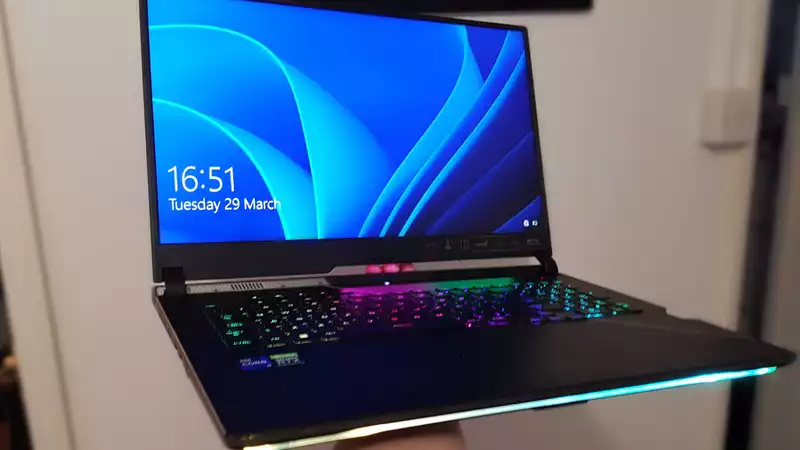It's clear that Asus is not holding back when it comes to the 2022 evolution of high-end ROG gaming laptops: the G733Z configuration of the Strix Scar 17 is a great example, with Nvidia's new and more powerful RTX 3070 Ti and Intel's Core i9 12900H The stunning combination is for sale. [With a 12th generation Alder Lake chip and a GPU with higher wattage than the RTX 3080, there is little competition at this price point. But can the rest of this laptop rival this massive configuration?
First impressions: gorgeous machine, but the chassis finish is prone to grease marks. Alan and Graeme don't really like the translucent, smoky corners of the chassis, but the translucency makes the design a bit more glamorous. At least from the back, it doesn't look like they're secretly playing LoL, giving it a subtle gamer vibe that could happily be used in the office.
The large ROG logo with RGB lighting is a bit noticeable, but the lighting effects can be turned off for a more subtle look.
Normally with a high-end laptop like this, subtlety goes out the window as you can hear the fans whine under load. This laptop, however, is surprisingly quiet. There's a lot of bluster, but no high-pitched noise that would upset someone without the best gaming headset to protect their ears. Unless it's in silent mode.
Sadly, the cooling system does not get the temperature as great as I would have liked. Even unshielded on my work desk, the GPU maxed out at 87°C (189°F) and the CPU hit 100°C (212°F) after a day of gaming. This is within specs, but at a level that makes one wonder if it is safe.
But if you're willing to risk the heat, here's what this Alder Lake beast can do:
We haven't had much opportunity to check out the 12th generation gaming laptops, but when compared to the previous generation CPUs, the difference is stark! .
The ROG Strix Scar 17's x264 video encoding score is not to be underestimated, and as for multi-core performance in the Cinebench rendering test, it is up 600 points against the Razer Blade 17's Core i7 12800H. It is also about 1800-2000 points ahead of the multi-core scores of the Ryzen 9 6900HS on the ROG Zephyrus G14 and the Ryzen 7 5800H on the Lenovo Legion Pro, respectively.
As for single-core, Scar manages to beat its closest competitor, the Ryzen 9 6900HS, by a little over 130 points. Impressive.
These give the Strix Scar 17 an edge in CPU-intensive games as well as productivity. For example, in Hitman's Dartmoor benchmark, the average fps is 120 and the lowest fps is 23, even with all particle effects turned off.
Metro Exodus also has a minimum of 47 fps and an average of 82 fps. This is not as good as Blade's RTX 3080 Ti, but at 150 watts the RTX 3070 Ti is really impressive. Compared to some of the portable RTX 3080 SKUs we tested (such as the 95W RTX 3080 on the MSI GS66 Stealth), we recorded 167 fps on F1 2020 and 113 fps on Horizon Zero Dawn, which is a gaming powerhouse! Proof. Indeed, this is well above the 130W limit of the previous generation. [The ray tracing performance of the ROG Strix Scar 17 sits between the portable RTX 3080 Ti and RTX 3070, miles above any AMD GPU configuration. Keep in mind that we often run benchmarks at ultra graphics settings and 1080p resolution for comparison, not the laptop's native 1440p.
At 1440p, we expect scores to drop below 100 fps, but not enough to justify lowering graphics in most cases.
Importantly, this much power comes at the cost of battery life as well as component temperatures. Sure, you won't be playing games unplugged very often, but if you do have to play, an hour is plenty of time to do so.
The Strix Scar touchpad doesn't appeal to me either. I try to click on the space below it and my poor, callous fingers forget where the edges are.
This particular model doesn't even come with a camera, which is overlooked for the price.
But to make up for it, there are a couple of USB Type-C ports on the back and a full-size keyboard, which is nice to have; if Asus has managed to cram such a huge configuration into this, the complaints I mentioned can easily be overlooked. The frankly unnecessary 32GB of DDR5-4800 RAM has an impressive memory bandwidth of 53.27GB/s, and the 2TB SSD can load FFXIV Shadowbringers in just over 10 seconds, a solid score.
For a machine with a 17-inch chassis, it doesn't weigh much and doesn't need two power adapters to reach its full potential. For all that, it doesn't feel like a huge desktop replacement like we've seen in the past. And that's fine. Especially for such a portable machine with a 1440p, 240Hz, 3ms response time IPS panel, which also does a great job of reducing glare.
You can get a Lenovo Legion 5 Pro with RTX 3070 for half the price, but spending $2,999 (£2,600) for this Strix Scar configuration will set you apart from the competition with little effort. Sure, it's not as stylish as the Blade 17, and the ray tracing isn't as adequate, but therein lies the $1,000 price difference. If it can outperform the laptops of yesteryear in almost every operation, I would pay that price.
.

Comments